 |
 Production I.G., Japan's best known best animation
studio, just completed a Ghost in the Shell-based series using
Illustrate!. More...
Production I.G., Japan's best known best animation
studio, just completed a Ghost in the Shell-based series using
Illustrate!. More...
|
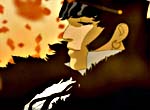 |
 "Corto Maltese" stars the
famous BD character, Corto Maltese, in his first animated feature film.
Ellipse Programme used Illustrate! for the rendering of the train sequence.
More...
"Corto Maltese" stars the
famous BD character, Corto Maltese, in his first animated feature film.
Ellipse Programme used Illustrate! for the rendering of the train sequence.
More...
|

|
Troy Robinson
An experienced technical illustrator, shows us how Illustrate!
has made his work almost automatic. More...
|
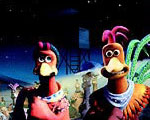 |
"Chicken Run" See
how, Aardman, the famous producers of "Wallace & Gromit"
used Illustrate! for previsualization and set design of this huge box-office
success. Expect to see more of Illustrate! in their next feature film
"Hare vs Tortoise" More...
|
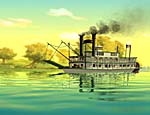 |
MGM (Metro-Goldwyn Mayer Inc.)
is creating complex cel animations quickly using Illustrate!. More...
|
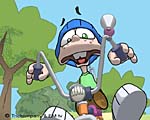
|
Trickompany produced
an incredible 300 episodes of "Junior Wrap Around" using
Illustrate! More...
|
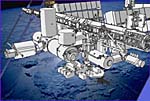 |
NASA is using Illustrate!
help design the next international space station. More...
|
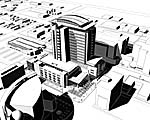
|
Tate and Snyder Architects
This architectural and design firm used Illustrate! to help design a 700,000
square foot Regional Justice Center. More...
|
 |
Curious Pictures
created a uniquely styled television series using Illustrate!. More...
|
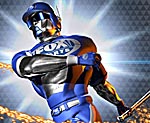 |
Digital Dimension
is quickly taking broadcast quality animations and repurposing them for
the internet using Illustrate! More...
|

|
Ron Zorman is applying
his unique approach to cartoons using Illustrate! More...
|
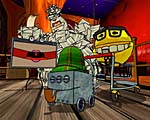
|
"TattleToons"
is a Dutch animation series with a daily preview on the TattleToons website.
The daily preview ends with a cliffhanger. More...
|
|

|
"Little Voices"
is a documentary; a vivid and harrowing perspective of the civil war in
Colombia seen through the personal experiences of children displaced by
the conflict. More...
|
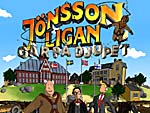
|
Korkeken, a Swedish
company, is using Illustrate! to create a game based on a series of popular
Swedish movies. More...
|
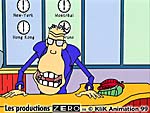 |
Klik Animation, Inc.
is pushing the limits by producing 2000 frames of broadcast quality animation
daily using Illustrate! More...
|
| |
"Ghost in the Shell: Stand Alone
Complex"
|
|
|



|
Production I.G. completed 26 episodes of their Ghost in the Shell-based
series Stand Alone Complex. 3D Festival recently had an interview
with Sakurai Yoshiki regarding this production.
"... Rendering was the most important aspect and I.G developed their
own cel-shader plug-in for Lightwave 3D. For 3ds max renders, I.G relied
on David Gould’s Illustrate! cel-shader plug-in... "
Sakurai Yoshiki
Complete
article...
|


|
| |
|
|
| |
"Corto Maltese: La Cour Secrete des
Arcanes"
|
|
|
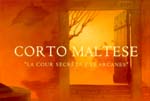

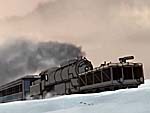

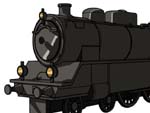
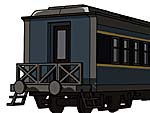
|
Interview with Dominique Gantois, supervisor of the train and plane sequences
in the film.
What is your artistic background?
I finished 4 years of Classical Animation Studies at the Royal Academy
of Fine Arts, Ghent, Belgium. I worked a couple of years as a 2D key animator
before entering the 3D world. I was one of the 10 happy winners of the
MTV competition FREE YOUR MIND this with a short film called "The
Wireframe People". After that I worked for 3 years as a supervising
animator on "Insektors".
Can you describe the project?
I'll quickly describe the storyline: Corto travels, with his 'friend'
Raspoutin through Siberia and China, jumping from one train to another,
looking for the 'Gold-Wagon'. Each train has it's own War Lord and destination.
Corto survives a plane and a train crash and meets wonderfull ladies,
but misses the gold.
The film was one of the biggest animation productions in Europe at the
time, and required a very high level of quality in all its aspects. I
looked at the trains and the plane not as effects shots, but as big "silent"
actors. They were always present and helped the story progress from one
place to another. The animation of the trains needed a "Corto-live
real look". Their timing need to be realistic yet fit the rythm of
the film. The smoke elements had to match the look of the hand-painted
clouds. The line rendererings had to match the style of the original Corto
books. The 3D backgrounds had to look like the hand-painted ones. The
trains and their rails had to fit neatly into the 2D backgrounds, which
didn't always have the right perspective.
Marrying backgrounds and train/smoke elements was more an aesthetic job.
The had to be beautifull shots in the first place. It was necessary to
work very closely with the director for those shots in which 2D animated
characters were interacting with the train. This resulted in the creation
of 3D soldiers, and even a 3D Corto and Rasputin in a couple of train
shots. 3D characters were use in all the plane shots.
Since the storyboards were constantly changing, especially those involved
action sequences, so a very flexible 3D and 2D work flow was need. Each
train had it's own basic scene, with train tracks, particles, winds and
an existing train already animated. In the heat of the production, I worked
on four machines at the same time.
What was your involvement with the project?
Initially I was asked to calculate layouts for 25 train shots that were
to be used by the Korean traditional animation team. The original process
for the train smoke was to composite real smoke onto 2D hand drawn trains.
This was too time-consuming and final result wasn't very convincing. After
just three days I prepared some tests that used a 3D train with line rendering
and 3D smoke. The director saw them and I was given the go-ahed to complete
56 train shots using this technique. Two months later this grew to 180
train shots and 25 plane shots. In fact, every exterior of the train is
3D.
I personally finished the 218 shots, from pre-production to modelling,
animation, particle-effects, rendering, and final compositing. For 25
of the shots the entire background was fully 3D. In all it took me 22
months to complete the 3D production work.
Why did you choose Illustrate! for your production needs?
I tested all the line rendering systems (five in total) that I could
find before the major start of the production. Illustrate! was the only
one that gave me the possibility to have the lines where I wanted them
and how I wanted them.
It was very important that the final look of the trains match the model
sheets. This also applied to the colors. Each part had its own specific
RGB value including a custom shadow color (this wasn't the result of simply
darkening the original color).
The Illustrate! material gave me everything I needed.
The details on the trains change as it gets closer. For a shot where
a train comes towards the camera, two separate ink passes, one with all
the details, another less detailed, were rendered. These were later blended
during compositing. Switching ink materials without selecting objects
was a big time saver. Having the ink and paint passes rendering once but
output to separate directories was also one of Illustrate!'s key features.
All the ink materials are accessible in one user interface so saving
and replacing them for each shot was very easy. Another important features
was Illustrate!'s interaction with AfterBurn. It allowed the creation
of perfect masks on the ink images.
Oh yes, Illustrate! is fast! It renders very fast.
Contact: Dominique Gantois
For more information about the film visit www.cortolefilm.com
|
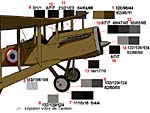
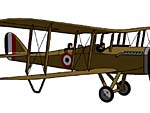
|
| |
|
|
| |
"Junior Wrap Around"
|
|
|

|
Interview with Bernie Denk, director, from Trickompany.
"Junior Wrap Around" is a series of 300 spots of 30 seconds
commisionned by EM tv through Trickompany of Germany. As overall Director
it was my responsability to create a unique visual style for the "Junior
wraparound" series. Coming from a traditional cartoon animation background
and more recently having embraced the world of 3D computer animation,
I looked for interesting ways of melding the two styles into one. Producing
"Junior" on the computer gave us a lot of flexibility and allowed an impressive
output of 6 minutes per week with a team of 14 animators . After trying
various toon shaders, we found that Illustrate! gave us exceptional results
and proved indispensable in giving "Junior" it's original cel look. The
latest version with all it's improvements and new features will give us
ever more stylistic possibilities and increase our productivity immensely
on the next season.
Side Note: Junior Wrap Around is shown in over
5 countries!
Contact: Bernie Denk
|
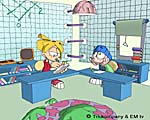
|
| |
|
|
| |
Curious Pictures
|
|
 |
Interview with Lewis Kofsky, technical director, at Curious Pictures.
What is your artistic background?
I have both an artistic and technical background. I have always gravitated
towards projects where I can mix the two. I have a design degree from
Stanford University, where I was involved in many projects that drew from
a variety of media.
What project are you currently working on?
Right now I am in the middle of a series of spots for Lugz Shoes. We are
creatinga a stop motion look in CG. I have used Illustrate! for a couple
of major productions. First I used it as a toonz renderer in Avenue amy.
We had already modelled photrealistic backgrounds and wanted to add some
more fantiastical elements. It was very quick to use Illustrate! to mix
a Cel look with our photoreal look. We ultimately settled on a look where
we drew some elements from the Illustrate! renderer and others from the
MAX scan line renderer. I also recently used Illustrate! in some shots
from Sheep in the Big City, which is a new cel animated series on cartoon
Network. I had to integrate cg shots seamlessly into an entirely hand
drawn show. We chose to do some of the work in CG because the shots would
have been too time consuming and difficult with traditional methods. We
were able to pull this off with Illustrate!.
Why did you chose Illustrate! for your production needs?
It was incredibly fast for us to learn, and easy to control. We also found
David very easy to work with and responsive to our needs.
Side Note: Avenue Amy was shown at SIGGRAPH
2000 Electronic Theatre!
Contact: Lewis Kofsky
|
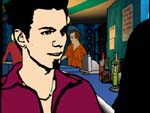 |
| |
|
|
| |
NASA
|
|
 |
Interview with Jason Budinoff from NASA.
What is your position and role at NASA?
I am an aerospace engineer working at the Goddard Space Flight Center
in Greenbelt, Maryland. I design mechanisms for use on satellites and
space-borne scientific instruments. I also do preliminary design studies
for exterior scientific instruments for the international space station.
What are the current projects you are using Illustrate! for?
I am currently using Illustrate! to render the space station, and for
illustrations of mechanisms I have designed for procedures documents and
papers. I have also used it for posters of the instrument I am currently
working on, ICESAT/GLAS.
Why did you choose Illustrate! for your production needs?
The design software we use, high-end IDEAS master series, and AutoCAD,
are horrible for making simple line drawings, which are required for my
papers and some presentations. I usually transfer the models into MAX
and then use the Illustrate! plugin renderer to make clear, easy-to-understand
diagrams. Illustrate! is the ONLY hidden-line renderer on the market that
gave me everything that I needed at such a great price.
Contact: Jason Budinoff
|
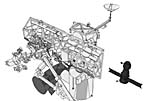 |
| |
|
|
| |
Digital Dimension
|
|
 |
LOS ANGELES, July 29, 1999 —The Bot is back! The FoxBot, that is. Continuing
the network’s popular robot theme throughout its sports programming, FOX
asked Digital Dimension (www.digitaldimension.com) to create a robotic
baseball player for their coverage of Major League Baseball (MLB).. Digital
Dimension had previously created CGI robots for FOX’s NHL and NFL broadcasts,
so, "it made a lot of sense for FOX Sports entrust us to create a brand
new CGI robot for the baseball season," said Ben Girard, President of
Digital Dimension. The FoxBot is used as an animated element for their
game openings and wipes during MLB on FOX broadcast. Digital Dimension
employed the newly released Max 3.0 (www.ktx.com) to create the 3D character.
According to Benoit, "the newly integrated modeling techniques built-in
MAX 3.0 were pivotal in our ability to use this highly detailed model
everywhere the network wanted to use it. We were able to smoothly convert
our high resolution model into a low polygon one to accommodate Internet
and game requirements." Furthermore, utilizing David Gould's Illustrate!
rendering technology, Digital Dimension was able to render directly to
the popular Macromedia Flash format, thus delivering to FOX the best possible
and most efficient method for distributing these animations on the Internet.
In addition to animator and supervisor Benoit "Ben" Girard his team of
animators (Edmund A. Kozin and Fernando Castillo handled character setup.and
overall construction of the character, while concept designs for the MLB
FoxBot were created by Fox Sports’ Gary Hartley. The hardware and software
included: GX1 Xeon Intergraph Computer, IBM Intellistation, Adobe Photoshop
in addition to Discreet MAX 3.0. Digital Dimension is an Emmy Award-winning
studio specializing in 3D animation, motion graphics, and visual effects
for the film, television, and interactive industry. The company won two
Emmys for their graphic design work on various FOX telecasts.
Contact: Digital Dimension
|
Flash Animations


 |
| |
|
|
| |
MGM Inc.
|
|
 |
Sean Platter is the Art Director at MGM and he describes how they using
Illustrate! to create complex animations.
What is your artistic background?
I've been drawing since I was a kid; graduated from college with a
broad 4 year degree in Visual Arts with an emphasis in graphic design.
I've been working in the Saturday Morning (TV) animation industry since
1985 as a production artist and now as an Art Director. On the side I
do illustrations for puzzles, games, and animation merchandise.
What project are you currently working on?
I am Art Director for MGM's latest animated Video Feature, "Tom Sawyer".
I have also become the production's self-appointed 3D animator as well.
We have a very detailed Steamboat in the production's opening and closing,
and I just hated to think of the torture someone would have to go through
to animate it by hand! ...Which is where Illustrate! comes to the rescue.
The combination of 3D Studio-MAX and Illustrate! are a great one to help
get this part of the production finished.
Why did you chose Illustrate! for your production needs?
I have tried virtually all other "animation", "cel", "cartoon", or hidden
line renderers out there for MAX and none offer subtle transparency controlsand
colored lighting like Illustrate! does. Illustrate also saves me time
by not forcing me to spend a couple days in the material editor like the
others. My modeling time is faster and face counts smaller because of
Illustrate's ability to detect intersecting surfaces in the models. Illustrate!
has speed and quality anti-aliasing, giving me the opportunity to output
feature film resolution images. With Illustrate! helping out on the production,
we can spend a little more time with our character animation... which
is always a good thing!
Thanks for the invitation to contribute my opinion regarding Illustrate!;
it is an important and necessary tool in my bag o' tricks!
Contact: Sean Platter
|
 |
| |
|
|
| |
Korkeken Interactive Studio
|
|
|


|
Johan Tornstrom is the project manager at Korkeken Interactive Studio,
a Swedish game and design company.
What is your technical/artistic background?
I´ve been working with 3D Studio for about 6 years. I never went to any
art school, instead I´ve learned everything I know at home experimenting.
What project are you currently working on?
The project I´m currently working on is called Jonssonligan, it´s based
upon a series of very popular Swedish movies. They are comedies about
a very clumsy criminal trio. In almost all their heists they end up in
jail without the loot, but somehow they always end up with something much
better. It´s very popular in Sweden and has been an ongoing series of
films since the early eighties.
Why did you chose Illustrate! for your production needs?
Because we wanted our game to look like a cartoon. We tried Cartoon Reyes,
Incredible Comic Shop and Vecta 3D. But we realized that Illustrate! is
the fastest cartoon renderer out there and it also produces the best quality
images.
Contact: Johan Tornstrom
|
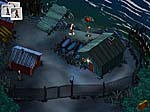
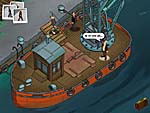
|
| |
|
|
| |
Klik Animation, Inc.
|
|
|


|
Laurent M. Abecassis is the technical director at Klik Animation and
he fills us in on their ground breaking work.
Hi, I'm in charge of the technology devlopment here, so I work with the
artists (modeler, animators, ...) to find new ways to produce quickly
wonderful characters.
Can you briefly describe who Klik Animation is?
KliK Animation is located in Montreal, Canada. Founded in June 97, KliK
Animation is a young and dynamic company specializing in the conception
and animation of 3D characters and the production of animated computer
graphics imaging. Sporting a dedicated team and a finely tuned production
philosophy, KliK uses no less than 20 softwares packages to attain and
maintain the highest standards in its production of synthetic characters
and environments.
What is your current project?
"Le JourNul de Francois Perusse". 1 Minute-Show On Air everyday, just
after the News. We produce the minute each day in less than 6 hours...
Why did you choose Illustrate! for your production needs?
We choose Illustrate! for our production ( Le JourNul de Francois Perusse
) because of its quality and speed of process, we test other cartoon renderer
and Illustrate! is really the fastest, with our series we need to render
more than 2000 frames in NO TIME and Illustrate! give us the best results.
Contact: Laurent M. Abecassis
Further Information
- The Animation World Magazine recently completed an extensive article
on this cutting edge company. To see this article refer to http://www.awn.com/mag/issue3.12/3.12pages/kenyonklik.php3
- For company contact details refer to Klik
Animation
- For further information about the series Le JourNul de Francois Perusee
refer to the producer's website http://www.zeromusic.com
|
 |
| |
|
|
| |
Troy Robinson
|
|
 |
An experienced artist, having worked for NBC and CBS affiliate TV, Troy
now works for the studio Anderson Images, Inc.
What is your artistic background?
Well, since I was originally planning on being an art teacher, I took
a lot of classes in High school and College that were traditional drawing
and painting classes. On the computer side, I've pretty much taught myself
what I need to know. Also, I have had the opportunity to work with some
very talented artists, who have shown me some great tricks and techniques.
What type of work do you specialize in?
My main focus is on 3d animation and illustration. Often the type of work
I end up working on is more of a technical nature, but I have also done
a few character pieces. I have tried also to not lock myself into any
one style, since often clients will want a different look. It's nice to
be able to be flexible in that regard.
How has Illustrate! helped in producing your work?
For some of the technical illustrations that I have been doing, I really
like being able to "ink" the edges of my renders. This gives me a different
look than a straight render, and it allows me to create the look of a
technical pen illustration. Since everything is still in 3D, I can easily
create multiple views of my illustrations by simply moving around in 3D.
Before Illustrate!, I would have to take each image into photoshop or
some other program, and draw out all the lines by hand over the top of
a render. Now, it is all automatic.
I can now output to Flash as well, and I am really excited about being
able to send a very clean animated drawing through this format. This format
is still pretty new to me though, so I am still learning.
Contact: Troy Robinson
|
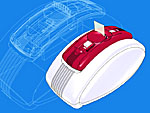 |
| |
|
|
| |
Ron Zorman
|
|
 |
What is your artistic background?
I studied classical animation and minored in computer animation at Emily
Carr College of Art and Design. I finished college in 1988 but had my
first professional job in animation during the summer of 1986 as an assistant
animator. Up until 1995 when I moved to LA I'd been employed as an Assistant
animator, Animator, Layout artist, Storyboard artist, Timing director
and Director. I'd had a wide range of experience over those years so when
I had an opportunity to move to LA to work in computer animation I took
it.
What type of work do you specialize in?
I specialize in character animation, traditional and computer. My last
computer job was in development where I was able to creatively express
my designs using various programs and plugins like Illustrate!
How has Illustrate! helped in producing your work?
David has done a fantastic job developing this plugin to suit a variety
of needs. This has been exactly what I've been looking for in a cartoon
renderer. I've tried the competitors and they haven't been able to give
me all the options and control I've been looking for. Now with Illustrate!
I'm able to realize my character designs the way I've envisioned. I'm
hoping to start my own cartoon short in the not too distant future and
you can bet I'll be using Illustrate! My thanks go out to David for offering
one of the best deals you can find on the web.
Contact: Ron Zorman
|


|
| |
|
|
| |
Tate & Snyder Architects
|
|
|


|
Tate and Snyder Architects staff of over 60 professionals handles projects
including educational, aviation, industrial, corporate, judicial, and
religious facilities. The firm has been using Autodesk products for over
10 years, and we currently have fifty seats of AutoCAD, two of Lightscape,
two of 3D Studio MAX and two of 3D Studio VIZ software. For design, we
do most of our work in 3D Studio MAX / VIZ, then export the files to AutoCAD
2000 software for production.
There is a close relationship between 2D and 3D work at our firm that
continues throughout the architectural process, with many working drawings
generated that are studied first in 3D Studio MAX / VIZ. The integration
of design with visualization has allowed us to make critical decisions
in the early stages of projects, saving us both time and money during
the drawing and construction phases, with fewer change orders. And it
allows us to offer our clients additional services. The Regional Justice
Center is a 700,000 SF facility co-locates four different court systems
including the Municipal, Justice, District and Supreme Courts in the high
rise tower. In the development of the Regional Justice Center in Las Vegas.
Why did you chose Illustrate! for your production needs?
Because we wanted our architectural design submissions to look more graphic.
We tried Cartoon Reyes and Vecta 3D but we found that Illustrate! is the
easiest cartoon renderer to use and produces the best quality image quality
regardless of price. Together, AutoCAD 2000 and 3D Studio MAX / VIZ and
Lightscape, with all the available plug-in possibilities including Daivid
Gould's Illustrate!, make the most powerful design solution I have seen
on any platform.
Contact: George Babakitis
|
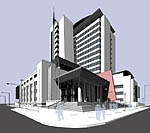 |
| |
|
|
| |
TattleToons
|
|
 |
TattleToons is a Dutch animation series with a daily preview on
the TattleToons website (http://www.vpro.nl/tattletoons). The daily preview
ends with a cliffhanger. Each afternoon, kids can chat ("tattle") online
with each other in the "TattleBox", to come up with nice ideas for the
next part of the series. Once a week, the complete result of the past
week is broadcast on Dutch national television. TattleToons has quickly
become a national hit for children between 7 and 13 years old.
TattleToons takes place in the world inside your computer. Ten different
characters were designed, each belonging to a particular group. For instance,
the Bug character belongs to the Hackers, Browser belongs to the Search
Engines, MP3 belongs to the Downloaders, and so on.
3DS MAX was used to model and animate the characters in front of pre-built
backgrounds. Illustrate! 5 was used to achieve a bright and clear cartoon
style and the speedy rendering times that were necessary to create about
one minute of animation a day.
Contact: Metin Seven
Credits
Project Manager: Frank Alsema / IJsfontein Interactive
Media (http://www.ijsfontein.nl)
Character Designers and Script Editors: Hanco Kolk and Mark Retera / Comic
House agency (http://www.comichouse.nl)
3D Modelers and Animators: Metin Seven / Seven's Heaven (http://www.sevensheaven.nl)
Pieter Snijders / IJsfontein
Interactive Media Flash Animator: Don Blaauw / IJsfontein
Interactive Media Video Editor: Ramon Oranje / IJsfontein Interactive
Media
|
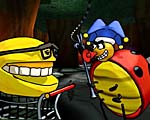
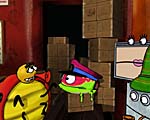
|
| |
|
|
| |
"Little Voices"
|
|
 |
I am developing a project which is called "Little Voices"
which is a documentary; a vivid and harrowing perspective of the civil
war in Colombia seen through the personal experiences of children displaced
by the conflict.
The piece will be developed from original drawings and recorded interviews
made by children at workshops which I led in Bogota, Columbia during the
displacement. He shows us his naïve involvement in cocaine production,
which ironically is the reality and cause of the war. Occupation of the
Red Cross Headquarters by refugees from the war in January 2000. The animation
will focus on the true life story of 11 year old Jaison Ferner. Jaison's
story begins in Tough Town; a lawless, violent place which reflects the
domestication of the conflict.
He shows us how it was shattered by bombing and also relives the simple
beauty of his life before I discover Illustrate! and really fit my feeling
of the style of the animation I want to achieve. I have found the best
way to animated children drawings is through the use of 3D computer animation
using Illustrate! which gives me the chance of using flat surfaces and
I can maintain the quality of children's drawings and keeping the professional
look the I want it.
The animation will have a 'naïve' childlike cartoonist style creating
a tension between the humor and innocence of the children's narration
and drawings with the horror of the stories being told. This will portray
more efficiently the absurd of this war.
The audience which I want to reach is adults so they will be more aware
of situations beyond great Britain and U.S.A, this animation will be portray
the life on child in this peculiar situation.
Visual Design
How the work will be realised and the processes involved processing children's
drawings using 2D and 3D software to develop narratives based on the children's
stories. Production work involves modelling and rendering scenes form
storyboards, editing to sound and recording onto Mini DV tape.
I have found the best way to animated children drawings is through the
use of 3D Computer animation using 3D max. By using flat surfaces I can
maintain the quality of children's drawings and produce professional control
of movement. Illustrate! will be used for the special look I want.
Sound
All the sound effects will be produced from recordings of the children
narrating their stories, which have already been completed. Even though
the are in Spanish we will do the voice over in English in order to reach
more people The music will be traditional by Juan Carlos Arenas, a Colombian
Musician commissioned from the funds raised.
Contact: Eduardo Carrillo
Eduardo is in need of further funding for his project, so please contact
him if you could help.
|
 |

![]() Production I.G., Japan's best known best animation
studio, just completed a Ghost in the Shell-based series using
Illustrate!. More...
Production I.G., Japan's best known best animation
studio, just completed a Ghost in the Shell-based series using
Illustrate!. More...
![]() "Corto Maltese" stars the
famous BD character, Corto Maltese, in his first animated feature film.
Ellipse Programme used Illustrate! for the rendering of the train sequence.
More...
"Corto Maltese" stars the
famous BD character, Corto Maltese, in his first animated feature film.
Ellipse Programme used Illustrate! for the rendering of the train sequence.
More...










































